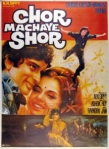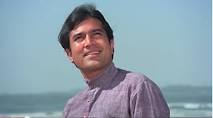A number of Hindi Film songs are memorable because of the humming. When you listen to such songs, you realise that the humming is an integral part of the song. The humming part normally comes before the actual song, like an Alaap in classical music. However, there are also songs where the humming sequence comes in the middle of the song or at the very end.
Normally, people associate humming with a melody that is sung with mouth closed that sounds like ‘hmmm’. However, humming means any melody sung without the lyrics – this can include a melody sung with an open mouth like ‘aaa’ or ‘ooo’.
Humming generally makes a song charming. Sometimes, the humming adds an unforgettable haunting element to the song. Naina Barse Rim Jhim composed by Madan Mohan for Woh Kaun Thi, is one such song with an opening humming that is extremely haunting. Listen to the opening humming here.
And the full song here.
Another song with a very haunting opening sequence is Tum Mile composed by MM Kreem for the film Criminal. While the main singers were Kumar Sanu and Alka Yagnik, the humming sequences are sung by KS Chitra. Criminal is a remake of a Telugu film. Chitra had sung the humming sequences for the Telugu song and the same sequences were used in the Hindi version as well. Apparently, KS Chitra took many days to practice the humming before it was approved and recorded.
MM Kreem is known by different names in different languages. In Telugu film industry, where he spent most of his career, he is known as MM Keeravani. He composed the music for Blockbusters like Baahubali and RRR. Listen to the haunting opening of Tum Mile here.
And the full song here.
While there are countless songs with humming, I shortlisted only 15 popular songs and created a playlist. These songs feature humming by the singer. I did not include songs where the humming sequence is sung by a chorus. Also, this post does not include songs with folksy hums or classical sargam.
Click the link below to listen to the playlist on Amazon Music. The songs in the playlist appear in the same order as in the post below.
Link to Playlist on Amazon Music
Charming Kishore – The beginning
The Alaap is a key element of classical songs. Normally, the Alaap is a hum that sets the mood for the song. In film music as well, the opening humming sets the mood like an Alaap.
Kishore Kumar was a well known singer from the early days of his career. However, Rafi was considered the leading singer and was normally the first choice for a song on a hero. Aaradhana was the film that changed this equation in film music.
Rajesh Khanna makes an appearance in a jeep and stole the hearts of everyone with the help of Kishore’s booming voice and the charming humming in Mere Sapnon Ki Raani. This film and Kishore Kumar’s songs in this movie rocked the film world and Kishore shot to the top, displacing Rafi. SD Burman (assisted by RD Burman) created these iconic songs in Aaradhana that changed the landscape. Aaradhana is a key milestone in the history of Hindi film music.
Another song from Aaraadhana, Kora Kaagaz thaa yeh man mera sung by Kishore and Lata, also had a memorable and charming opening humming sequence.
Kishore’s voice was ideally suited for humming (of course, he was one of the rare singers who could yodel) and composers like RD Burman added several charming opening humming sequences in songs like O mere dil ke chain (Mere Jeevan Saathi), Tum Bin (Pyar Ka Mausam), Aane waala pal (Golmaal).
Kalyanji-Anandji also used Kishore’s humming memorably in Samaa hai Suhaana (Ghar Ghar Ki Kahani) and O Saathi Re (Muqaddar Ka Sikandar).
Hemant – the Haunting Hummer
Hemant Kumar was blessed with a deep bass voice. His voice was also well suited for humming. Two of his own compositions in his own voice, had haunting humming sequences – an opening one in Tum Pukaar Lo (Khamoshi) and one in the middle and end in Ye Nayan Dare Dare (Kohraa).
Apart from his songs in his own voice, he also composed a memorable haunting humming sequence in Lata’s voice in Kahin Deep Jale, from Bees Saal Baad. For many listeners, this song is an iconic song of the haunting type.
The Middle and End
There were quite a few memorable songs where the humming sequence was at the middle or end of the song.
Apparently, Shanker (of Shanker-Jaikishen duo) was playing the song Pyar Hua Ikraar Hua (Shree 420) for Raj Kapoor to approve. Instinctively, Jaikishen sang the humming sequence in his own voice in the middle of the song. Everyone liked the song with the hum and it was approved!
Lata’s song, Ab to hai tumse (Abhimaan) opens with a humming sequence. But, for me, the more appealing humming sequence is in the middle. It is one more example (among countless ones) of Lata’s mastery of the pitch and the outstanding quality of her voice. Listen to the humming sequence in the middle here.
Ravi’s iconic song about the joys of nature, He Nile Gagan Ke tale (Hamraaz) also has a lovely high pitched humming sequence by Mahendra Kapoor in the middle.
Lata’s Humming – no end
C Ramchandra composed an iconic song Yeh Zindagi Usiki hai in Anarkali. The humming in the opening sequence by Lata is like a signature for this unforgettable song.
One of the most charming songs with humming in the beginning, middle and end is Lata’s Yeh Dil Aur Unki from Prem Parbat. Jaidev composed this lovely song set in the hills and streams.
Regional humming
GK Venkatesh, a popular music composer in the South, composed an unusual song in Kannada and Telugu in the voices of SP Balasubrahmanyam and S Janaki. In this song titled Ravi Varma ki (the telugu movie name is a tongue twister – Raavanude Raamudaithe), the song is sung entirely by SP Balasubrahmanyam. S Janaki does not sing and only hums throughout the song. This is a well composed song that became hugely popular in the South mainly because of the charming humming melody and of course, SP Balasubrahmanyam’s singing. I added this song to the 15 Hindi film songs in the playlist above.
Hindi film music has countless songs with humming. I highlighted only a few popular ones. I am sure there will be many more that could potentially be a part of this theme of Humming. Hats off to the talented composers who created such charming humming songs – and some haunting humming songs too. I hope you enjoyed the songs and the commentary.











 Nutan starrer Saudagar also had lovely songs (before Amitabh became a big name) with Lata’s Tere mera saath rahe standing out for the melody.
Nutan starrer Saudagar also had lovely songs (before Amitabh became a big name) with Lata’s Tere mera saath rahe standing out for the melody.
 touch. Another Shashi Kapoor starrer Fakira also had a popular duet Tota Maina Ki Kahani, again with a sweet touch of flute.
touch. Another Shashi Kapoor starrer Fakira also had a popular duet Tota Maina Ki Kahani, again with a sweet touch of flute.








 pleasant. In many cases, the composers also used technology and instruments imaginatively to create attractive embellishments to the melodies.
pleasant. In many cases, the composers also used technology and instruments imaginatively to create attractive embellishments to the melodies.
 major role to play in the music of Tridev in the late 80s. He was an arranger and musician for a number of music directors. Mohra was his breakthrough movie as a composer. Again, Viju Shah deserves a lot of credit for creating a blockbuster musical hit in a movie full of gory killings, revenge and deception. Subah se lekar shaam tak is a delightful romantic melody with pleasant arrangements.
major role to play in the music of Tridev in the late 80s. He was an arranger and musician for a number of music directors. Mohra was his breakthrough movie as a composer. Again, Viju Shah deserves a lot of credit for creating a blockbuster musical hit in a movie full of gory killings, revenge and deception. Subah se lekar shaam tak is a delightful romantic melody with pleasant arrangements.







 song in Geet, Jiske sapne humen roz aate rahe that also makes brilliant use of flute. Apart from the lovely flute interludes, observe the delightful use of flute as a countermelody.
song in Geet, Jiske sapne humen roz aate rahe that also makes brilliant use of flute. Apart from the lovely flute interludes, observe the delightful use of flute as a countermelody.

 for this special place. A number of his songs were light, elegant, easy on the ears and leave you enchanted with a pleasant feeling. He had a distinct style of composition that seemed to make the songs flow quickly with brisk and graceful movements among notes. His passion for Western classical music and flair for instrumentation also made his songs cheerful to lift your mood as if you were waltzing on the clouds!
for this special place. A number of his songs were light, elegant, easy on the ears and leave you enchanted with a pleasant feeling. He had a distinct style of composition that seemed to make the songs flow quickly with brisk and graceful movements among notes. His passion for Western classical music and flair for instrumentation also made his songs cheerful to lift your mood as if you were waltzing on the clouds!
 ony. And enjoy the brisk and graceful movements in Rim jhim ke yeh pyaare pyaare (Usne kahaa tha) that make the song a delight. The interludes contain a blend of western symphony type arrangements and Indian arrangements. And as a grand final flourish, Lata sings effortlessly in western classical style at the end of the song. Baagh mein kali (Chanda aur Suraj) is one more song where you can experience a delightful combination of Indian melody and western arrangements.
ony. And enjoy the brisk and graceful movements in Rim jhim ke yeh pyaare pyaare (Usne kahaa tha) that make the song a delight. The interludes contain a blend of western symphony type arrangements and Indian arrangements. And as a grand final flourish, Lata sings effortlessly in western classical style at the end of the song. Baagh mein kali (Chanda aur Suraj) is one more song where you can experience a delightful combination of Indian melody and western arrangements.
 ts stood him in good stead in transitioning into the 1970s. While he used saxophone in the 60s imaginatively, in the seventies he shifted to trumpets! Observe the beautiful use of trumpets in Zindagi kaisi hai paheli (Anand).
ts stood him in good stead in transitioning into the 1970s. While he used saxophone in the 60s imaginatively, in the seventies he shifted to trumpets! Observe the beautiful use of trumpets in Zindagi kaisi hai paheli (Anand).





 orchestration, there are sounds of western symphonies, ‘conversations’ between the keyboard and violin, beautiful use of humming, seamless transition from western to traditional instruments and as a final flourish in the song, the blending of the sounds of violin and the humming. And all of these superb combinations and blends are in addition to a wonderful vocal melody!
orchestration, there are sounds of western symphonies, ‘conversations’ between the keyboard and violin, beautiful use of humming, seamless transition from western to traditional instruments and as a final flourish in the song, the blending of the sounds of violin and the humming. And all of these superb combinations and blends are in addition to a wonderful vocal melody! choice of notes and pitch determine the melodic content to some extent. Also, the extent of wavy contours, graceful patterns in the vocals denote varying degrees of melodic content in an orthodox style of composition.
choice of notes and pitch determine the melodic content to some extent. Also, the extent of wavy contours, graceful patterns in the vocals denote varying degrees of melodic content in an orthodox style of composition. ing his talent and creativity into a well presented song. Though RD Burman made his debut in 1961 with Chote Nawab, the late 60s and early 70s saw RD Burman at his best in both these dimensions – he seemed to ascend the stairs to success at a rapid rate. And the songs simply seemed to gush out in full flow; full of creativity, inspiration and abundant talent.
ing his talent and creativity into a well presented song. Though RD Burman made his debut in 1961 with Chote Nawab, the late 60s and early 70s saw RD Burman at his best in both these dimensions – he seemed to ascend the stairs to success at a rapid rate. And the songs simply seemed to gush out in full flow; full of creativity, inspiration and abundant talent.
 Amar Prem marked a high point in RD Burman’s classical based melodies. Raina beeti jaaye (Amar Prem) is a superb classical based number. Lata’s singing, the graceful undulations in the song and stress on key notes are truly sublime and make this an
Amar Prem marked a high point in RD Burman’s classical based melodies. Raina beeti jaaye (Amar Prem) is a superb classical based number. Lata’s singing, the graceful undulations in the song and stress on key notes are truly sublime and make this an




 His songs were predominantly simple melodies. His music may not appear extravagant or carry the ‘flourishes’ of the top music directors of the golden era. However, since his melodies were simple, they were appealing, easy to sing and extremely hummable. Ravi boasted that he could create a tune from almost any set of words, including newspaper headlines or columns! It would not have been very difficult for him. Give him santoor, flute, tabla players and a newspaper and I can imagine him creating simple tunes from the newspaper.
His songs were predominantly simple melodies. His music may not appear extravagant or carry the ‘flourishes’ of the top music directors of the golden era. However, since his melodies were simple, they were appealing, easy to sing and extremely hummable. Ravi boasted that he could create a tune from almost any set of words, including newspaper headlines or columns! It would not have been very difficult for him. Give him santoor, flute, tabla players and a newspaper and I can imagine him creating simple tunes from the newspaper.



 Some of Ravi’s songs can be considered among the best songs in their category and live on as evergreen songs. Chaundvin Ka Chand ho (Chaundvin Ka Chand) is one such top of the category evergreen songs for solo romantic songs. And who can forget Yeh Raaten Yeh Mausam (Dilli ka thug), the romantic evening duet set against moonlight, stars and water! Dilli ka thug also featured yet another evergreen song – CAT Cat, Cat mane billi, the song that puts life into anyone and any situation.
Some of Ravi’s songs can be considered among the best songs in their category and live on as evergreen songs. Chaundvin Ka Chand ho (Chaundvin Ka Chand) is one such top of the category evergreen songs for solo romantic songs. And who can forget Yeh Raaten Yeh Mausam (Dilli ka thug), the romantic evening duet set against moonlight, stars and water! Dilli ka thug also featured yet another evergreen song – CAT Cat, Cat mane billi, the song that puts life into anyone and any situation.